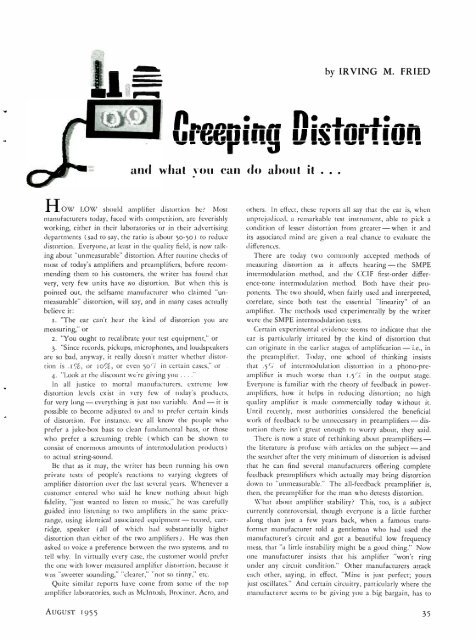Aug - AmericanRadioHistory.Com
Aug - AmericanRadioHistory.Com
Aug - AmericanRadioHistory.Com
Create successful ePaper yourself
Turn your PDF publications into a flip-book with our unique Google optimized e-Paper software.
iAAM.i.N<br />
by IRVING M. FRIED<br />
.AA w<br />
1211:1:1111111 111N 1111'111m<br />
Zti14I %% hat Oil Call iIi ulOut it . . .<br />
HOW LOW should amplifier distortion be?<br />
Most<br />
manufacturers today, faced with competition, are feverishly<br />
working, either in their laboratories or in their advertising<br />
departments (sad to say, the ratio is about 5o -5o) to reduce<br />
distortion. Everyone, at least in the quality field, is now talking<br />
about "unmeasurable" distortion. After routine checks of<br />
most of today's amplifiers and preamplifiers, before recommending<br />
them to his customers, the writer has found that<br />
very, very few units have no distortion. But when this is<br />
pointed out, the selfsame manufacturer who claimed "unmeasurable"<br />
distortion, will say, and in many cases actually<br />
believe it:<br />
1. The ear can't hear the kind of distortion you are<br />
measuring," or<br />
2. "You ought to recalibrate your test equipment," or<br />
3. "Since records, pickups, microphones, and loudspeakers<br />
are so bad, anyway, it really doesn't matter whether distortion<br />
is .1 %, or ro %, or even 5Orß in certain cases," or<br />
4. "Look at the discount we're giving you ...."<br />
In all justice to mortal manufacturers, extreme low<br />
distortion levels exist in very few of today's products,<br />
for very long - everything is just too variable. And - it is<br />
possible to become adjusted to and to prefer certain kinds<br />
of distortion. For instance, we all know the people who<br />
prefer a juke -box bass to clean fundamental bass, or those<br />
who prefer a screaming treble (which can be shown to<br />
consist of enormous amounts of intermodulation products)<br />
to actual string- sound.<br />
Be that as it may, the writer has been running his own<br />
private tests of people's reactions to varying degrees of<br />
amplifier distortion over the last several years. Whenever a<br />
customer entered who said he knew nothing about high<br />
fidelity, "just wanted to listen to music," he was carefully<br />
guided into listening to two amplifiers in the same price -<br />
range, using identical associated equipment - record, cartridge,<br />
speaker ( all of which had substantially higher<br />
distortion than either of the two amplifiers). He was then<br />
asked to voice a preference between the two systems, and to<br />
tell why. In virtually every case, the customer would prefer<br />
the one with lower measured amplifier distortion, because it<br />
was "sweeter sounding," "clearer," "not so tinny," etc.<br />
Quite similar reports have come from some of the top<br />
amplifier laboratories, such as McIntosh, Bro ciner, Acro, and<br />
AUGUST 1955<br />
others. In effect, these reports all say that the ear is, when<br />
unprejudiced, a remarkable test instrument, able to pick a<br />
condition of lesser distortion from greater - when it and<br />
its associated mind are given a real chance to evaluate the<br />
differences.<br />
There are today two commonly accepted methods of<br />
measuring distortion as it affects hearing -the SMPE<br />
intermodulation method, and the CCIF first -order difference<br />
-tone intermodulation method. Both have their proponents.<br />
The two should, when fairly used and interpreted,<br />
correlate, since both test the essential "linearity" of an<br />
amplifier. The methods used experimentally by the writer<br />
were the SMPE intermodulation tests.<br />
Certain experimental evidence seems to indicate that the<br />
ear is particularly irritated by the kind of distortion that<br />
can originate in the earlier stages of amplification - i.e., in<br />
the preamplifier. Today, one school of thinking insists<br />
that .5eí of intermodulation distortion in a phono -preamplifier<br />
is much worse than 1.5!'f in the output stage.<br />
Everyone is familiar with the theory of feedback in power -<br />
amplifiers, how it helps in reducing distortion; no high<br />
quality amplifier is made commercially today without it.<br />
Until recently, most authorities considered the beneficial<br />
work of feedback to be unnecessary in preamplifiers-dis -<br />
tortion there isn't great enough to worry about, they said.<br />
There is now a state of rethinking about preamplifiers -<br />
the literature is profuse with articles on the subject -and<br />
the searcher after the very minimum of distortion is advised<br />
that he can find several manufacturers offering complete<br />
feedback preamplifiers which actually may bring distortion<br />
down to "unmeasurable." The all- feedback preamplifier is,<br />
then, the preamplifier for the man who detests distortion.<br />
What about amplifier stability? This, too, is a subject<br />
currently controversial, though everyone is a little further<br />
along than just a few years back, when a famous transformer<br />
manufacturer told a gentleman who had used the<br />
manufacturer's circuit and got a beautiful low frequency<br />
mess, that "a little instability might be a good thing." Now<br />
one manufacturer insists that his amplifier "won't ring<br />
under any circuit condition." Other manufacturers attack<br />
each other, saying, in effect, "Mine is just perfect; yours<br />
just oscillates." And certain circuitry, particularly where the<br />
manufacturer seems to be giving you a big bargain, has to<br />
35
















